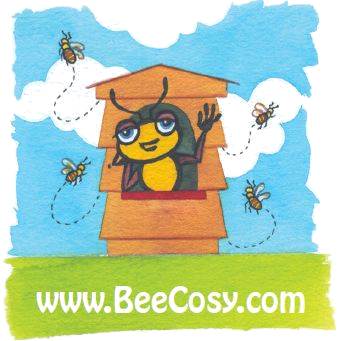So why should you use insulation?
If you already use some form of insulation, you will be pleased to know that our tests indicate that insulation can have a significant impact on internal hive temperatures and the level of stores consumed.
The graph below compares internal hive temperatures under the roof of two similar hives / colonies over an evening in November. The top blue line shows a hive with a Bee Cosy, the red a hive without. The bottom black line is the outside temperature.
With insulation, temperature levels can be seen to be 2 to 3 degrees higher.
Research by Seeley in 1982 estimated that the metabolic rate of a bee colony increased from 4 Watts per Kg of bees to 16 watts per kg of bees as temperatures dropped from 10C (50F) to -20C (-4F).
So each degree C drop in temperature raises metabolic energy levels by about 0.4 Watts/Kg (12 Watts increase / 30 Degrees fall).
A normal winter colony of say 15,000 bees weighs 1.5 Kg. So if temperatures could be raised from 3C to 5C then a colony would save 1.2 Watts per hour (1.5 x 0.4 x 2).
Over a 4 month period this would equate to saving 3,456 watt hours for a colony of bees (1.2 Watts per hour x 24 hours x 30 days x 4 months).
A 3kw kettle takes about 3 minutes (1/20th of an hour) to boil 1.7litres of water i.e. 150 watt hours (3Kw * 1000 / 20). So we are saving our bees the equivalent of the extra stores needed to boil 22 kettles by raising internal hive temperatures from 3C to 5C.
The impact of the Bee Cosy at lower temperatures is even greater - Raising temperatures from -1C to 1C would be equivalent to boiling 45 kettles!
Jurgen Tautz's book "The Buzz about Bees" explains that 1 Kg of honey is equivalent to 330 Watts of energy (1,000 kJ) but it is unclear how much of this energy is used for other uses by the bees i.e. movement as it is used. Even if we assume a low figure of 20% would be used for heating then in this example we could be saving 2 Kg of honey (3,456 Watts / 330 x 20%).
Whilst we can find no research that has translated energy saving to a reduction in the amount of honey consumed, last winter (2011), a colony protected by a Bee Cosy went through winter with only 9 Kg of stores. This is a lot less than the 18 Kg of stores recommended as needed by the BBKA. This is why many solutions to improve wintering conditions for honeybees have been developed.

